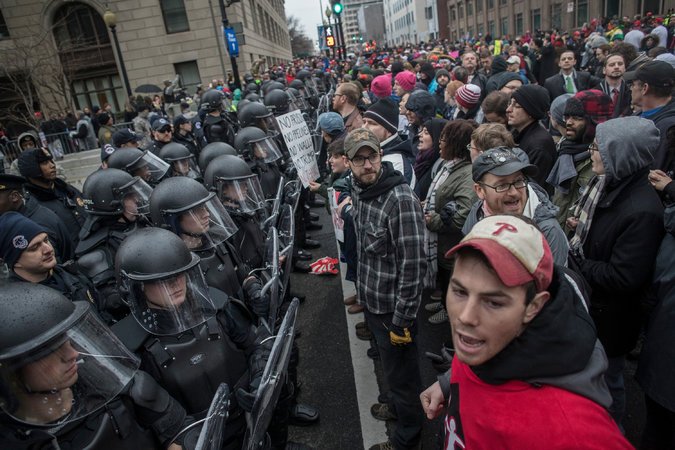“The government has not informed me as to why Mr. Wood’s case involved any greater degree of culpability than of the other journalists who were ultimately not charged,” Mr. Cohen said in an email.
On his website, Mr. Wood said that “resistance cultures and conflicts” were his beat. He works as a commercial photographer on the side, his lawyer said.
An April 3 indictment, which lists eight charges against Mr. Wood and 211 other defendants, “does not single out Mr. Wood for anything arising from the demonstration,” Mr. Cohen said. A spokesman for the Justice Department said he would not comment on pending cases.

Gregg Leslie, the legal defense director for the Reporters Committee for Freedom of the Press, suggested that the Justice Department’s reason for proceeding with its case against Mr. Wood might lie somewhere in his 42-minute Facebook Live video of the Jan. 20 demonstrations.
Mr. Wood’s lawyer, however, said the video showed that his client was innocent of the charges against him.
Advertisement
Continue reading the main story
The footage shows Mr. Wood taking digital-camera photographs, usually from the sidelines, as he live-streams the event. Several times he runs to the front of the group of demonstrators to get a different shot.
Occasionally Mr. Wood is heard letting out a cry of “Whoo!” as he captures protesters in the act of spray-painting buildings and throwing rocks through windows. A few times he turns the camera to himself, showing his reactions as the protest escalates.
“I could see someone at the D.O.J. saying this is what a protester does,” Mr. Leslie said.
According to Reed Brody, a lawyer who represented the reporter Amy Goodman, who faced rioting charges in 2016 after covering the protests of the Dakota Access oil pipeline in North Dakota, a journalist’s attitude toward a protest is not germane.
“Obviously, journalists are not above the law — they can’t break windows,” Mr. Brody said. “They can be sympathetic to the people that they cover, and they can draw attention to the people that they cover. But you can’t arrest and you can’t charge journalists for covering events.”
Newsletter Sign Up
Continue reading the main story
Thank you for subscribing.
An error has occurred. Please try again later.
You are already subscribed to this email.
Toward the end of the video, as the police are about to move in, Mr. Wood is seen identifying himself as a member of the media.
Mr. Cohen said Mr. Wood had done nothing illegal. “I believe the government understands the import of charging Mr. Wood but still continues to do so, despite the First Amendment issues,” Mr. Cohen said.
Alexandra Ellerbeck, the North America program coordinator for Committee to Protect Journalists, said the law must distinguish between those who covered demonstrations and the participants.
“Criminal laws should require criminal intent, and so if a journalist is covering the story, that does not constitute criminal intent,” Ms. Ellerbeck said. “He wasn’t vandalizing property, and the charges against him are incredibly extreme.”
The Washington Metropolitan Police seemingly ignored journalists who presented their credentials, including Mr. Wood, who is seen flashing a press badge in the video.
Advertisement
Continue reading the main story
“The police used the actions of a few window breakers as an excuse of a mass roundup,” said Scott Michelman, a senior staff attorney at the American Civil Liberties Union in Washington.
The other journalists arrested at K and 12th Streets on Jan. 20 were Evan Engel, a senior producer at Vocativ; Jack Keller, a producer of the web documentary series “Story of America”; Matthew Hopard, a freelance photojournalist whose work has been published by The New York Times and Fox News; Alexander Stokes, an independent journalist who has a show on a public access news channel in Albany; Cheney Orr, a freelance photographer; Alexander Rubinstein, a reporter with RT America; and Shay Horse, a freelance photojournalist whose work has been published by Rolling Stone, Al Jazeera America and other outlets.
This law enforcement tactic of arresting people in large numbers at protests — known as kettling — was used in Toronto during a Group of 20 protest in 2010 and during more recent demonstrations in North Dakota and St. Louis.
In those instances, it seemed that police officers did not distinguish between the alleged lawbreakers and those covering the events. Afterward, Ms. Ellerbeck said, journalists were “forced through a legal process that is expensive and arduous and scary — and all the more so if you’re a freelance journalist.”
Mr. Wood, who declined to be interviewed for this article, expressed his feelings about the trial in a blog post on his photography website. “I’ve been confronted with my biases yet I am embodying a ‘journalist’ identity more than ever,” he wrote. “I honor that duty to a professional level.”
Mr. Wood is one of 31 journalists who have been arrested while on the job in the United States in 2017, according to U.S. Press Freedom Tracker.
Continue reading the main story
Article source: https://www.nytimes.com/2017/11/14/business/media/alexei-wood-journalist-trial-inauguration.html?partner=rss&emc=rss
Speak Your Mind
You must be logged in to post a comment.